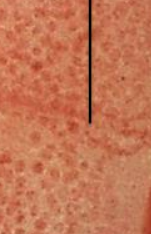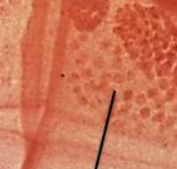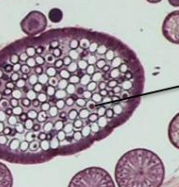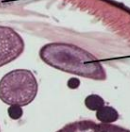Lab 13 - Platyhelminthes and Nematoda
1/108
Earn XP
Description and Tags
BIO112 - Dr. Shauna Price
Name | Mastery | Learn | Test | Matching | Spaced |
|---|
No study sessions yet.
109 Terms
What are the characteristics of bilaterians?
Triploblastic
Bilaterally symmetrical
Have complex organ systems
Protostomes or deuterostomes
Have types of body cavities
What does triploblastic mean?
The presence of three germ layers in an organisms embryo.
What are the germ layers of a triploblastic organism called?
Ectoderm - outer layer
Mesoderm - middle layer
Endoderm - inner layer
What is bilateral symmetry associated with? (System)
The presence of a central nervous system and cephalization.
What is a protostome?
An organism who’s mouth forms first from the blastospore.
What is a deuterostome?
An organism who’s anus forms first from the blastospore.
What is defined as a body cavity?
A fluid/air-filled space between the digestive tract and external surface.
What are the functions of a body cavity?
Structure
Nutrient and gas transportation
Movement
Organ cushioning/protection
What germ layer of a triploblastic organism is the body wall derived from?
The ectoderm layer.
What germ layer of a triploblastic organism is the central tissues derived from?
The mesoderm layer.
What germ layer of a triploblastic organism is the digestive tract derived from?
The endoderm layer.
What are the different kinds of body types?
Acoelomate
Pseudocoelomate
Coelomate
What are the characteristics of an acoelomate body type?
Acoelomate bodies lack a body cavity therefore the organisms organs are embedded into the mesoderm tissue of the body with the digestive track running through the middle.
What genus has the acoelomate body type?
Planarian.
What are the characteristics of a pseudocoelomate body type?
Pseudocoelomate bodies have a body cavity where the body walls are lined with mesoderm tissue but not the digestive track that runs through the middle.
What is the body cavity of a pseudocoelomate body type called?
Pseudocoelom.
What genus has the pseudocoelomate body type?
Nematode.
What are the characteristics of a coelom body type?
Coelom bodies have a body cavity where the body walls and the digestive track that runs through the middle are lined with mesoderm tissue.
What is the body cavity of a coelomate body type called?
Coelom.
What genus has the coelomate body type?
Polychaete.
What is the scientific name for the front end of a bilaterally symmetrical organism?
The anterior end.
What is the scientific name for the back end of a bilaterally symmetrical organism?
The posterior end.
What is the scientific name for the top side of a bilaterally symmetrical organism?
The dorsal side.
What is the scientific name for the bottom side of a bilaterally symmetrical organism?
The ventral side.
What is cephalization?
The development of a head in an organism.
What is the central nervous system?
The concentration of sensory organs and neural processing in the head that coordinates movement.
What are two other systems of a bilaterian?
the excretory and reproductive systems.
What is a worm?
Any invertebrate with a long cylindrical body.
What are the two phyla of worms studied?
Platyhelminthes and Nematoda.
Why are Platyhelminthes and Nematoda studied together? Are they evolutionarily related?
They are studied together because they share several characteristics and have free-living and parasitic species' but are NOT evolutionarily related.
What does the prefix “platy-” mean? What organisms does the Platyhelminthes phyla contain?
The prefix “platy-” means plate, therefore the phyla contains flatworms.
What does the prefix “nema-” mean? What organisms does the Nematoda phyla contain?
The prefix “nema-” means round, therefore the phyla contains roundworms.
What are parasites?
Organisms that derive nutrition and habitat from a host that they harm in return.
What are endoparasites?
Parasites that live within the body of their hosts.
What are exoparasites?
Parasites that live on the external surface of their host.
What are some challenges parasites face?
Getting into/on their hosts
Reproduction
Effecting their host
Why is getting into a host a challenge for a parasite?
When a parasite finds a host (a challenge in and of itself) they must figure out how to avoid their immune system in order to survive inside of it.
Why is reproduction a challenge for a parasite?
Once inside of a host (needed for survival) they can only find mates within the host organism.
Why is effecting the host a challenge for a parasite?
They must make sure not to effect their host too much to prevent their death because if thier host dies the chances of the parasite’s survival is low.
What is a parasite’s host(s) called when going through the young larval state?
The intermediate host(s) since the parasite will move into a different one to live on indefinitely.
What a parasite’s host called when in the adult stage?
The definitive host that eventually eggs are released in.
What is the parasitic life cycle?
Egg → larval stage — enters intermediate host → larval stage — enters definitive host → adult
What are the characteristics of flatworms?
They are triploblastic, protostomic, acoelomate organisms with a GVC, a central nervous system and are capable of gas exchange.
What does the GVC aid in a flatworm?
The delivery of oxygen and nutrients throughout their body.
What does a flatworm need in order to be able to cause gas exchange? Where does it happen?
An aquatic or damp environment and a flat body is needed in order for has exchange to occur through the epidermis layer.
What is a ganglia in a flatworm?
Clusters of nerve cells that act as the “brain” located in their head.
What is a ventral nerve cord? How many are in flatworms and where are they?
Elongated clusters of nerve cells, two of them are located on one side of the organism.
How many sets of muscles do flat worms have for movement? What are they called?
Three, the dorsoventral, longitudinal, and circular sets.
What features besides muscles do flatworms use for movement?
Cilia and mucus.
What are free-living flatworms studied called?
Planarians.
What are parasitic flatworms studied called?
Flukes and tapeworms.
What are the fluke types studied?
The sheep liver and blood flukes.
What are the eye spots of a planaria organism called? What do they do?
Ocelli, they sense lights rather than actually see.
What is the sensory lobe of a planaria called? What can they sense?
Auricles, they sense chemicals in the environment, serving as the olfactory sense.
What is the pharynx in planaria? What is it’s purpose? Where does it open?
A muscular tube they use for ingestion of prey that opens at the mouth in the center of the organism.

What is this image pointing to?
The longitudinal muscle.

What is this image pointing to?
The circular muscle.

What is this image pointing to?
The epidermis.

What is this image pointing to? What is this developed by (germ layer)?
The dorsal muscle developed by the mesenchyme.
What are the characteristics of flukes?
They have a special epidermis in order to resist immune systems, suckers for gripping their hosts, and are mainly made up of reproductive organs.
What is the larval stage of flukes called?
Cercaria.
What are the typical intermediate hosts of flukes?
Snails.
What are the typical definitive hosts of flukes?
Vertebrates.
What is the sex of sheep flukes?
They are hermaphroditic.
What are the female reproductive organs of a sheep fluke?
Ovaries, uterus, yolk glands, yolk duct.
What are the male reproductive organs of a sheep fluke?
Testes and vas deferens.
What is the purpose of the yolk gland of a sheep liver fluke?
Nourishing eggs.
What is the purpose of the yolk ducts in sheep liver flukes?
Egg transportation.
What is the purpose of the genital pore?
Opening for reproductive systems.
What is the purpose of the seminal receptacle?
Storing and receiving sperm.
How do sheep liver flukes get into their definitive hosts?
Larvae leave snails forming clusters on plants that are then eaten by animals (typically cows, sheep, pig, and humans.
How do sheep liver eggs spread?
Since they are laid in the intestines they spread though the hosts feces then once formed into larvae they get into snails.
What parasite gravelly affect humans?
The blood flukes.
What are the characteristics of blood flukes? (In terms of reproduction)
They have separate sexes but the adults stay paired together for reproduction.
How do blood flukes infect their host?
They burrow into their skin and migrate through blood vessels as they become adults.
What are the characteristics of tapeworms?
Long parasitic hermaphroditic flatworms that lack digestive, respiratory, and circulatory organ systems.
What is the scolex in tapeworms?
Their anterior end that contains the suckers and hooks.
What are the suckers and hook for in a tapeworm’s scolex?
They are used for holding on to their hosts.
What are proglottids?
The different segments in a tapeworm’s body.
Where are the reproductive structures in a tapeworm?
The proglottids on the posterior end of the organism.
How do tapeworms reproduce?
Since each segment is hermaphroditic, they fill up with eggs then fall off.

What is this arrow pointing too?
The ovaries of a tapeworm.

What is this arrow pointing to?
The uterus of a tapeworm.

What is this arrow pointing to?
The testes of a tapeworm.

What is this arrow pointing to?
The vagina of a tapeworm.

What is this arrow pointing to?
The vans deferens of a tapeworms.

What is this arrow pointing to?
The genital pore of a tapeworm.
How do tapeworms spread?
Typically from humans eating beef from infected cows.
What are nematode characteristics?
Triploblastic, protostome, pseudocoelomate, with complete digestive and nervous systems and allow gas exchange.
How do nematodes move?
Through a set of longitudinal muscles.
What are nematode’s characteristics? (in terms of reproduction)
Most have separate sexes with different reproductive parts.
What is the excretory system in nematodes?
Their way of eliminating waste through tubes covered by a tough layer of cuticle.
What is the free-living nematode studied?
Vinegar eels.
What are the parasitic nematodes studied?
Ascaris and Trichinella.
What do vinegar eels feed off of?
Microbial cultures used to make vinegar.
What organism does the ascaris parasite typically infect?
Humans and pigs.
What is the structure of the female reproduction system for female ascaris?
Each worm has two ovaries, oviducts, and uteri.

What is this arrow pointing to?
A uterus of a ascaris.

What is this arrow pointing to?
The excretory tube of a ascaris.

What is this arrow pointing to?
An oviduct of an ascaris (hard to tell if oviduct or ovary so for out purposes they are interchangeable).